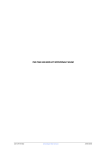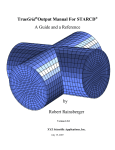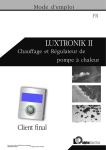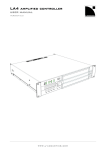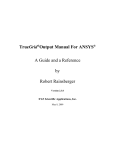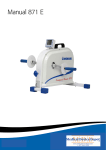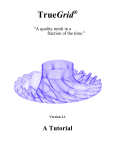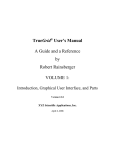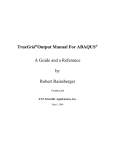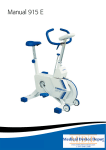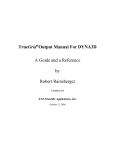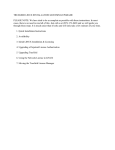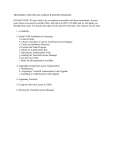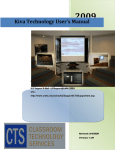Download TrueGrid ® Output Manual for KIVA
Transcript
TrueGrid®Output Manual For KIVA4 A Guide and a Reference by David J. Torres and Robert Rainsberger Version 2.3.0 XYZ Scientific Applications, Inc. February 1, 2007 Copyright © 2007 by XYZ Scientific Applications, Inc. All rights reserved. TrueGrid,® the TrueGrid® Output Manual for KIVA4, and related products of XYZ Scientific Applications, Inc. are copyrighted and distributed under license agreements. Under copyright laws, they may not be copied in whole or in part without prior written approval from XYZ Scientific Applications, Inc. The license agreements further restrict use and redistribution. XYZ Scientific Applications, Inc. makes no warranty regarding its products or their use, and reserves the right to change its products without notice. This manual is for informational purposes only, and does not represent a commitment by XYZ Scientific Applications, Inc. XYZ Scientific Applications, Inc. accepts no responsibility or liability for any errors or inaccuracies in this document or any of its products. TrueGrid ®is a registered trademark of XYZ Scientific Applications, Inc. Some other product names appearing in this book may also be trademarks or registered trademarks of their trademark holders. Copyright © 2007 by XYZ Scientific Applications, Inc. All Rights Reserved ii February 1, 2007 TrueGrid® Output Manual For KIVA4 Table of Contents Table of Contents . . . . . . . . . . . . . . . . . . . . . . . . . . . . . . . . . . . . . . . . . . . . . . . . . . . . . . . . . . . . . 3 I. Introduction . . . . . . . . . . . . . . . . . . . . . . . . . . . . . . . . . . . . . . . . . . . . . . . . . . . . . . . . . . . . . . . 5 II. KIVA4 Output Guide . . . . . . . . . . . . . . . . . . . . . . . . . . . . . . . . . . . . . . . . . . . . . . . . . . . . . 11 III. Example Problem 1 . . . . . . . . . . . . . . . . . . . . . . . . . . . . . . . . . . . . . . . . . . . . . . . . . . . . . . . 13 IV. Example Problem 2 . . . . . . . . . . . . . . . . . . . . . . . . . . . . . . . . . . . . . . . . . . . . . . . . . . . . . . . 31 V. KIVA4 Output Reference . . . . . . . . . . . . . . . . . . . . . . . . . . . . . . . . . . . . . . . . . . . . . . . . . . 35 kivabc KIVA4 Boundary Condition (Part Phase) . . . . . . . . . . . . 35 kivabci KIVA4 Boundary Condition (Part Phase) . . . . . . . . . . . . 35 kivabc KIVA4 Boundary Condition (Merge Phase) . . . . . . . . . . 36 co kivabc KIVA4 Boundary Conditions Display (Merge Phase) . . . 37 VI. INDEX . . . . . . . . . . . . . . . . . . . . . . . . . . . . . . . . . . . . . . . . . . . . . . . . . . . . . . . . . . . . . . . . . 39 Copyright © 2007 by XYZ Scientific Applications, Inc. All Rights Reserved TrueGrid® Output Manual For KIVA4 February 1, 2007 3 Copyright © 2007 by XYZ Scientific Applications, Inc. All Rights Reserved 4 February 1, 2007 TrueGrid® Output Manual For KIVA4 I. Introduction KIVA-4 is an engine simulation code which accommodates unstructured grids. KIVA-4 does impose restrictions on the unstructured grid if the snapping routines are used. The snapping routines allow layers of cells within the piston to be added or removed and layers of cells to alternately assume a role of solid valve surfaces. If the snapping routines are used, the mesh must be vertically layered in the cylinder. Specifically a vertical column of cells in the cylinder must be composed of only hexahedra or only prisms if the mesh is to be snapped. KIVA-4 assumes all elements (including tetrahedra, prisms and pyramids) are logically equivalent to a hexahedra. Figure 1 shows the node ordering for a hexahedral cell. One can create non-hexahedral cells by degenerating nodes. Figures 2-4 show how nodes can be degenerated in KIVA-4 to create other types of elements. Figure 1 Node ordering for hexahedral cell Copyright © 2007 by XYZ Scientific Applications, Inc. All Rights Reserved TrueGrid® Output Manual For KIVA4 February 1, 2007 5 Figure 2 Node ordering for a prism cell. The left face has been collapsed to an edge. Figure 3 Possible node ordering for pyramid cell. Copyright © 2007 by XYZ Scientific Applications, Inc. All Rights Reserved 6 February 1, 2007 TrueGrid® Output Manual For KIVA4 Figure 4 Possible node ordering for tetrahedral cell. KIVA-4’s mesh format requires one to define cell types and face types. Figure 5 shows the face conventions used for a cell in KIVA-4. Each face of a cell needs to be defined with a face type. Figure 6 shows the cell types that would be defined in a typical engine mesh. Figure 7 shows the corresponding exterior faces types that would be defined. Interior face types would be defined to be fluid. Copyright © 2007 by XYZ Scientific Applications, Inc. All Rights Reserved TrueGrid® Output Manual For KIVA4 February 1, 2007 7 Figure 5 Face conventions in KIVA-4 for a cell. Figure 6 Cell types in a typical engine mesh. Copyright © 2007 by XYZ Scientific Applications, Inc. All Rights Reserved 8 February 1, 2007 TrueGrid® Output Manual For KIVA4 Figure 7 Face types in a typical engine mesh. The boundary between the bowl and the squish region should be a fluid boundary but the walls of the bowl should be moving boundaries. KIVA-4 uses the following cell types with their numerical values in parenthesis: squish (10): flbowl (11): fldome (14): flfluid (20,30,40,50): Cells in the cylinder region should be of squish type. Cells in a piston bowl should be of flbowl type. A separate dome region can be created, if desired. Cells in ports should be identified as flfluid cells. The exact value of flfluid to be used depends on the port ordering (the first port should have cells with type 20, the second port should have cells with type 30, etc.). KIVA-4 uses the following face types with their respective numerical values in parenthesis: moving (10,11,12,13,14, ...): For faces that reside on a moving surface (e.g. piston crown, bowl faces, top and bottom of valves). solid (20): For faces that reside on a solid non-moving surface (e.g. cylinder walls, port walls). The sides of valves are considered solid surface despite the fact that they move. Copyright © 2007 by XYZ Scientific Applications, Inc. All Rights Reserved TrueGrid® Output Manual For KIVA4 February 1, 2007 9 solidh(21): axis(30): fluid(40): periodf(50): periodd(60): inflow(70): outflow(80): presin(90): presout(100): For faces that reside on the top or head of the cylinder. These surfaces can be labeled solid if the piston does not move. However if the piston does move, the faces should be labeled solidh surfaces. For faces that coincide with an axis. The axis faces are only used in 2D or 3D sector geometries. These faces are actually edges because they are faces of hexahedra that have been collapsed to a line segment. For any non-periodic face through which fluid can freely pass. For faces on the front periodic boundary of a mesh. For faces on the derriere periodic boundary of a mesh. For faces on an inflow boundary. For faces on a continuative outflow boundary. For cell faces on a pressure inflow boundary. For faces on a pressure outflow boundary. The mesh file name in KIVA-4 is called kiva4grid. The input deck is called itape5. Valve movement can be specified using a file called itape18. Copyright © 2007 by XYZ Scientific Applications, Inc. All Rights Reserved 10 February 1, 2007 TrueGrid® Output Manual For KIVA4 II. KIVA4 Output Guide The kiva command selects the KIVA4 output option. It can be issued in the control or merge phase. In the merge phase, use the write command to write the kiva4grid file. Be sure to merge the nodes using one of the merging commands such as stp before you write the output file. This is the standard procedure in TrueGrid®. There are a few special considerations required when building a KIVA4 model. There are no material properties to specify. However, the mt, mti, and mate commands are used to assign predefined materials to the mesh. The following material numbers can be used: 1 2 10 11 14 20 30 40 50 for squish (TrueGrid® default) for inactive for squish for bowl for dome for port 1 for port 2 for port 3 for port 4 Use the kivabc or the kivabci commands in the part phase or the kivabc command in the merge phase to set face types, except for periodic conditions. The default interior face type is fluid. The default exterior face type is solid. Care is needed in assigning the axis boundary condition. The edge that is placed on the axis must be a degenerate face. From outward appearances, this will be an edge of a wedge element. However, the internal representation of the wedge is be a hex element with 6 faces. When building the part that falls on the axis, use the computation window to select the degenerate face. Then use the kivabc command to assign the axis boundary condition to this face. The Block Boundary (bb) and the Transitional Block Boundary (trbb) commands have the periodf (for the front of a periodic boundary condition) and the periodd (for the derriere of a periodic boundary condition) options. The periodic boundary condition cannot be set using the kivabc command. The bb and trbb commands with these options accomplishes 3 things. 1. When an appropriate coordinate transformation is applied either to the master or the slave side of the block boundary, the nodal coordinates of the slave side are forced to be periodic with the master side. 2. This command, using the periodf and periodh options, produce the periodic boundary condition. Copyright © 2007 by XYZ Scientific Applications, Inc. All Rights Reserved TrueGrid® Output Manual For KIVA4 February 1, 2007 11 3. The same options also produce the node-to-node correspondence for the periodic constraints. The nodes of a master block boundary interface will appear first in the list of paired periodic vertices. You can generate prisms, tetrahedrons, and pyramid elements by attaching some nodes of an element to other nodes of the same element. This is the way to create what is referred to in TrueGrid® as degenerate hexahedral elements. Only prism (or wedge) elements are allowed on the axis of a periodic boundary condition. All four types are allowed elsewhere in the mesh. Only the axis boundary condition has meaning on a degenerate face and only if it degenerates to an edge. Some of these conditions are due to the requirement that the periodf and periodd faces, when found on a single element, must be on opposing faces. If precision is an issue, you may need to use the double precision version of TrueGrid®. This can become an issue with periodic boundaries because the slave side (derriere) must be exactly the master side (front) when the inverse periodic transformation is applied to the slave side. The single precision version of TrueGrid® may produce errors in the last digit. Copyright © 2007 by XYZ Scientific Applications, Inc. All Rights Reserved 12 February 1, 2007 TrueGrid® Output Manual For KIVA4 III. Example Problem 1 This is a simple example of a piston with 2 valves. When creating a model, Figures 8-12 can help in designing the mesh. Figures 8-10 show the cell types used, and Figures 11-12 show the face types used in the mesh. Figure 7 is also helpful in determining what face types should be used. Figure 8 Cell types used for 2-valve engine mesh. The cylinder region is designated squish (10), the first port and runner are designated flfluid (20) and the second port and runner are designated (30). Copyright © 2007 by XYZ Scientific Applications, Inc. All Rights Reserved TrueGrid® Output Manual For KIVA4 February 1, 2007 13 Figure 9 Cross-section view of cell types used in 2-valve engine mesh. Copyright © 2007 by XYZ Scientific Applications, Inc. All Rights Reserved 14 February 1, 2007 TrueGrid® Output Manual For KIVA4 Figure 10 Top view of cell types in 2-valve engine mesh. Note the use of O-grids in the valve and cylinder perimeters. Copyright © 2007 by XYZ Scientific Applications, Inc. All Rights Reserved TrueGrid® Output Manual For KIVA4 February 1, 2007 15 Figure 11 Cross -section view of face types for the first valve. Note that the valve and the valve stem are solid. Figure 12 Cross-section view of face types for the second valve. Note that the edges of the valve and the valve stem are solid. Copyright © 2007 by XYZ Scientific Applications, Inc. All Rights Reserved 16 February 1, 2007 TrueGrid® Output Manual For KIVA4 The problem is broken into 6 parts. Parts 1 and 3 form the stem. The part is extended through the entire model and the material below the extent of the stem is set to squish. The other parts are built around the stem parts. Figure 13 Stem parts The valve heads and the fluid around them are formed by parts 2 and 4. The cores are missing because they are formed by parts 1 and 3. Transitions are used for increase the mesh density out from the stem as the radius increases. Figure 14 Valve head parts Copyright © 2007 by XYZ Scientific Applications, Inc. All Rights Reserved TrueGrid® Output Manual For KIVA4 February 1, 2007 17 Part 5 forms the two ports that connect to the fluid around the valve ports. To assure that these parts match, nod for node, block boundary interfaces were formed. Figure 15 Port parts The last part is the bulk of cylinder around parts 1-5. Care was taken to form a topology that gave a nearly perfect o-grid at the outer radius while giving a nearly orthogonal mesh around the two ports. The elliptic smoothing was used extensively for this effect. Figure 16 Cylinder part Copyright © 2007 by XYZ Scientific Applications, Inc. All Rights Reserved 18 February 1, 2007 TrueGrid® Output Manual For KIVA4 Figure 17 Fully merged parts Copyright © 2007 by XYZ Scientific Applications, Inc. All Rights Reserved TrueGrid® Output Manual For KIVA4 February 1, 2007 19 Figure 18 Final mesh with temperature contours in computational simulation with KIVA-4. The final mesh contains 129,768 nodes and 124096 hex elements. The model is parametric, so both shape and size are easily adjusted. Copyright © 2007 by XYZ Scientific Applications, Inc. All Rights Reserved 20 February 1, 2007 TrueGrid® Output Manual For KIVA4 The following is the resulting session file with comments inserted to help the reader. The TrueGrid® User’s Manual for a full discussion on generating a mesh. These commands are included to demonstrate a complete model for KIVA4. title TrueGrid test problem for KIVA4 c Choose KIVA4 as the output format kiva c Simplify the part commands since there are no shells intyp 2 parameter r1 1 c radius of the valve stem r2 5 c radius of the port r3 7 c radius of the valve head r4 30 c radius of the cylinder d1 12 c offset from center of the valve d2 8 c width of the inlet/outlet d3 1 c thickness of the valve head d4 9 c depth of valve 1 d5 12 c depth of valve 2 d6 .4 c thickness of first transition region z1 50 c hieght of cylinder z2 60 c hieght of bottom of inlet/outlet z3 68 c hieght of top of inlet/outlet r5 [sqrt(%d1*%d1+%r3*%r3+2*%d1*%r3/sqrt(2))] ; c Surfaces needed to form the mesh sd 1 cy 0 0 0 0 0 1 %r4 c cylinder wall sd 2 cy [-%d1] 0 0 0 0 1 %r1 c valve stem port 1 sd 3 cy [-%d1] 0 0 0 0 1 %r2 c port 1 sd 4 cy [-%d1] 0 0 0 0 1 %r3 c valve head port 1 sd 5 cy %d1 0 0 0 0 1 %r1 c valve stem port 2 sd 6 cy %d1 0 0 0 0 1 %r2 c port 2 sd 7 cy %d1 0 0 0 0 1 %r3 c valve head port 2 sd 8 plan 0 [-%d2/2] 0 0 1 0 c back face of inlet/outlet sd 9 plan 0 [%d2/2] 0 0 1 0 c front face of inlet/outlet sd 10 plan 0 0 0 0 0 1 c bottom of cylinder sd 11 plan 0 0 %z1 0 0 1 c top of cylinder sd 12 plan 0 0 %z2 0 0 1 c bottom of inlet/outlet Copyright © 2007 by XYZ Scientific Applications, Inc. All Rights Reserved TrueGrid® Output Manual For KIVA4 February 1, 2007 21 sd 13 plan 0 0 %z3 0 0 1 c top of inlet/outlet sd 14 plan 0 0 [%z1-%d4] 0 0 1 c depth of top face of valve 1 sd 15 plan 0 0 [%z1-%d4-%d3] 0 0 1 c depth of bottom of valve 1 sd 16 plan 0 0 [%z1-%d5] 0 0 1 c depth of top face of valve 2 sd 17 plan 0 0 [%z1-%d5-%d3] 0 0 1 c depth of bottom of valve 2 sd 18 cy 0 0 0 0 0 1 %r5 sd 19 cy [-%d1] 0 0 0 0 1 [(%r2+%r3)/2] c construction port 1 sd 20 cy %d1 0 0 0 0 1 [(%r2+%r3)/2] c construction port 2 sd 21 cy [-%d1] 0 0 0 0 1 [%r1+%d6] c valve stem port 1 sd 22 cy %d1 0 0 0 0 1 [%r1+%d6] c valve stem port 2 c Valve stem 1 block 1 2 5 6; 1 2 5 6; 1 51 61 69; [-%r1/3-%d1] [-%r1/3-%d1] [%r1/3-%d1] [%r1/3-%d1] [-%r1/3] [-%r1/3] [%r1/3] [%r1/3] 0 %z1 %z2 %z3 c Delete the corners of the butterfly topology dei 1 2 0 3 4;1 2 0 3 4;; c Project to the cylinder sfi -1 -4;-1 -4;;sd 2 c Save the interfaces bb 2 1 1 3 1 4 1; bb 4 2 1 4 3 4 2; bb 2 4 1 3 4 4 3; bb 1 2 1 1 3 4 4; c Insert additional partitions to connect to the port insprt 1 5 2 9 insprt 1 5 2 1 c Project to the cylinders sfi ;; -2;sd 15 sfi ;; -3;sd 14 c Assign material numbers mt 1 1 2 0 0 6 2 c valve stem inactive mt 1 1 1 0 0 2 10 c fluid below valve stem Copyright © 2007 by XYZ Scientific Applications, Inc. All Rights Reserved 22 February 1, 2007 TrueGrid® Output Manual For KIVA4 c Glue the exposed faces together for smoothing bb 1 2 1 2 2 6 40; bb 2 1 1 2 2 6 40; bb 3 1 1 3 2 6 41; bb 3 2 1 4 2 6 41; bb 3 3 1 4 3 6 42; bb 3 3 1 3 4 6 42; bb 2 3 1 2 4 6 43; bb 1 3 1 2 3 6 43; c Smoothe the mesh unifm 1 2 1 4 3 1 & 2 3 1 3 4 1 & 2 1 1 3 2 1 20 0.001 1 ; unifm 1 2 2 4 3 2 & 2 3 2 3 4 2 & 2 1 2 3 2 2 20 0.001 1 ; unifm 1 2 3 4 3 3 & 2 3 3 3 4 3 & 2 1 3 3 2 3 20 0.001 1 ; unifm 1 2 4 4 3 4 & 2 3 4 3 4 4 & 2 1 4 3 2 4 20 0.001 1 ; unifm 1 2 5 4 3 5 & 2 3 5 3 4 5 & 2 1 5 3 2 5 20 0.001 1 ; unifm 1 2 6 4 3 6 & 2 3 6 3 4 6 & 2 1 6 3 2 6 20 0.001 1 ; c Assign non-default boundary conditions kivabci -1 -4;-1 -4;3 -6;solid kivabc 1 1 2 4 4 2 movingb1 endpart c Valve 1 block 1 3 8 9 18 19 24 26; 1 3 8 9 18 19 24 26; 1 51 61 69; [-%r1/3-%d1] [-%r1/3-%d1] [-%r1/3-%d1] [-%r1/3-%d1] [%r1/3-%d1] [%r1/3-%d1] [%r1/3-%d1][%r1/3-%d1] [-%r1/3][-%r1/3] [-%r1/3] [-%r1/3] [%r1/3] [%r1/3] [%r1/3] [%r1/3] 0 %z1 %z2 %z3 c Delete regions to form a butterfly topology dei 1 4 0 5 8;1 4 0 5 8;; dei 4 5;4 5;; c Nodal distributions for smoother mesh res 2 4 1 3 5 4 i .85 res 6 4 1 7 5 4 i [1/.85] res 4 2 1 5 3 4 j .85 res 4 6 1 5 7 4 j [1/.85] c Project to surfaces sfi -1 -8;-1 -8;;sd 4 Copyright © 2007 by XYZ Scientific Applications, Inc. All Rights Reserved TrueGrid® Output Manual For KIVA4 February 1, 2007 23 sfi -2 -7;-2 -7;;sd 3 sfi -3 -6;-3 -6;;sd 21 c Transition from a coarse mesh in the stem trbb 4 4 1 5 4 4 1; trbb 5 4 1 5 5 4 2; trbb 4 5 1 5 5 4 3; trbb 4 4 1 4 5 4 4; c Save interfaces bb 4 1 1 5 1 2 5; bb 8 4 1 8 5 2 6; bb 4 8 1 5 8 2 7; bb 1 4 1 1 5 2 8; c Insert partitions insprt 1 4 4 1 insprt 1 4 5 7 c Project sfi -1; -6; 3 4;sd 9 sfi -1; -5; 3 4;sd 8 c Save interface bb 1 5 3 1 6 4 30; c More inserted partitions insprt 1 5 2 9 insprt 1 5 2 1 c More projections sfi ;; -2;sd 15 sfi ;; -3;sd 14 c Assign material numbers mt 1 1 2 0 0 3 2 mt 1 1 4 0 0 6 20 mt 1 1 1 0 0 2 10 mt 1 1 3 0 0 4 10 c Assign boundary conditions kivabc 1 1 2 8 10 2 movingb1 Copyright © 2007 by XYZ Scientific Applications, Inc. All Rights Reserved 24 February 1, 2007 TrueGrid® Output Manual For KIVA4 kivabc 1 1 3 8 10 3 movingt1 kivabci -1 -8;-1 -10;2 3;solid endpart c Valve stem 2 block 1 2 5 6; 1 2 5 6; 1 51 61 69; [-%r1/3+%d1] [-%r1/3+%d1] [%r1/3+%d1] [%r1/3+%d1] [-%r1/3] [-%r1/3] [%r1/3] [%r1/3] 0 %z1 %z2 %z3 c Delete the corners of the butterfly topology dei 1 2 0 3 4;1 2 0 3 4;; c Project to the cylinder sfi -1 -4;-1 -4;;sd 5 c Save the interfaces bb 2 1 1 3 1 4 11; bb 4 2 1 4 3 4 12; bb 2 4 1 3 4 4 13; bb 1 2 1 1 3 4 14; c Insert additional partitions to connect to the port insprt 1 5 2 12 insprt 1 5 2 1 c Project to the cylinders sfi ;; -2;sd 17 sfi ;; -3;sd 16 c Assign material numbers mt 1 1 2 0 0 6 2 mt 1 1 1 0 0 2 10 c Glue the exposed faces together for smoothing bb 1 2 1 2 2 6 44;bb 2 1 1 2 2 6 44; bb 3 1 1 3 2 6 45;bb 3 2 1 4 2 6 45; bb 3 3 1 4 3 6 46;bb 3 3 1 3 4 6 46; bb 2 3 1 2 4 6 47;bb 1 3 1 2 3 6 47; Copyright © 2007 by XYZ Scientific Applications, Inc. All Rights Reserved TrueGrid® Output Manual For KIVA4 February 1, 2007 25 c Smoothe the mesh unifm 1 2 1 4 3 1 & 2 3 1 3 4 1 & 2 1 1 3 2 1 20 0.001 1 ; unifm 1 2 2 4 3 2 & 2 3 2 3 4 2 & 2 1 2 3 2 2 20 0.001 1 ; unifm 1 2 3 4 3 3 & 2 3 3 3 4 3 & 2 1 3 3 2 3 20 0.001 1 ; unifm 1 2 4 4 3 4 & 2 3 4 3 4 4 & 2 1 4 3 2 4 20 0.001 1 ; unifm 1 2 5 4 3 5 & 2 3 5 3 4 5 & 2 1 5 3 2 5 20 0.001 1 ; unifm 1 2 6 4 3 6 & 2 3 6 3 4 6 & 2 1 6 3 2 6 20 0.001 1 ; c Assign non-default boundary conditions kivabci -1 -4;-1 -4;3 -6;solid kivabc 1 1 2 4 4 2 movingb2 endpart c Valve 2 block 1 3 8 9 18 19 24 26; 1 3 8 9 18 19 24 26; 1 51 61 69; [-%r1/3+%d1] [-%r1/3+%d1] [-%r1/3+%d1] [-%r1/3+%d1] [%r1/3+%d1] [%r1/3+%d1] [%r1/3+%d1][%r1/3+%d1] [-%r1/3][-%r1/3] [-%r1/3] [-%r1/3] [%r1/3] [%r1/3] [%r1/3] [%r1/3] 0 %z1 %z2 %z3 c Delete regions to form a butterfly topology dei 1 4 0 5 8;1 4 0 5 8;; dei 4 5;4 5;; c Nodal distributions for smoother mesh res 2 4 1 3 5 4 i .85 res 6 4 1 7 5 4 i [1/.85] res 4 2 1 5 3 4 j .85 res 4 6 1 5 7 4 j [1/.85] c Project to surfaces sfi -1 -8;-1 -8;;sd 7 sfi -2 -7;-2 -7;;sd 6 sfi -3 -6;-3 -6;;sd 22 c Transition from a coarse mesh in the stem trbb 4 4 1 5 4 4 11; trbb 5 4 1 5 5 4 12; Copyright © 2007 by XYZ Scientific Applications, Inc. All Rights Reserved 26 February 1, 2007 TrueGrid® Output Manual For KIVA4 trbb 4 5 1 5 5 4 13; trbb 4 4 1 4 5 4 14; c Save interfaces bb 4 1 1 5 1 2 15; bb 8 4 1 8 5 2 16; bb 4 8 1 5 8 2 17; bb 1 4 1 1 5 2 18; c Insert partitions insprt 1 4 4 1 insprt 1 4 5 7 c Project sfi -8; -6; 3 4;sd 9 sfi -8; -5; 3 4;sd 8 c Save interface bb 8 5 3 8 6 4 31; c More inserted partitions insprt 1 5 2 12 insprt 1 5 2 1 c More projections sfi ;; -2;sd 17 sfi ;; -3;sd 16 c Assign material numbers mt 1 1 2 0 0 3 2 mt 1 1 4 0 0 6 30 mt 1 1 1 0 0 2 10 mt 1 1 3 0 0 4 10 c Assign boundary conditions kivabc 1 1 2 8 10 2 movingb2 kivabc 1 1 3 8 10 3 movingt2 kivabci -1 -8;-1 -10;2 3;solid endpart c inlet/outlet Copyright © 2007 by XYZ Scientific Applications, Inc. All Rights Reserved TrueGrid® Output Manual For KIVA4 February 1, 2007 27 block 1 21 0 22 42; 1 8; 1 9; [-1.5*%r4] [-%d1-%r3] 0 [%d1+%r3] [1.5*%r4] [-%d2/2] [%d2/2] %z2 %z3 c Save interfaces bb 2 1 1 2 2 2 30; bb 4 1 1 4 2 2 31; c Assign material numbers mt 1 1 1 2 2 2 20 mt 4 1 1 5 2 2 30 c Assign boundary conditions kivabc 1 1 1 1 2 2 presin kivabc 5 1 1 5 2 2 presout endpart c Main cylinder block 1 3 12 21 30 32; 1 3 12 14 23 25 34 36; 1 51; [-%r4] [-%r5] [-%d1+%r3] [%d1-%r3] %r5 %r4 [-%r4] [-%r5] [-%d1] [-%r3] %r3 %d1 %r5 %r4 0 %z1 c Add elements mseq i 5 0 9 0 5 mseq j 5 0 5 0 5 0 5 c Delete blocks to form a butterfly topology dei 1 3 0 4 6; 1 3 0 6 8;; dei 2 3 0 4 5; 4 5;; c Move some of the key vertices inti position pb 3 5 1 3 5 2 xy [-%d1+%r3*cos(45)] [%r3*sin(45)] pb 1 6 1 3 8 2 xy [-%d1+%r3*cos(45)] [%r3*sin(45)+5] pb 4 5 1 4 5 2 xy [%d1-%r3*cos(45)] [%r3*sin(45)] pb 4 6 1 6 8 2 xy [%d1-%r3*cos(45)] [%r3*sin(45)+5] Copyright © 2007 by XYZ Scientific Applications, Inc. All Rights Reserved 28 February 1, 2007 TrueGrid® Output Manual For KIVA4 pb 3 4 1 3 4 2 xy [-%d1+%r3*cos(45)] [-%r3*sin(45)] pb 1 1 1 3 3 2 xy [-%d1+%r3*cos(45)] [-%r3*sin(45)-5] pb 4 4 1 4 4 2 xy [%d1-%r3*cos(45)] [-%r3*sin(45)] pb 4 1 1 6 3 2 xy [%d1-%r3*cos(45)] [-%r3*sin(45)-5] c Node distribution other than equal spacing for smoothness res 6 3 1 6 6 2 j 1 res 1 3 1 1 6 2 j 1 res 1 3 1 2 6 2 i .85 res 3 1 1 4 2 2 j .85 res 3 7 1 4 8 2 j [1/.85] res 5 3 1 6 6 2 i [1/.85] c Project sfi -1 -6; -1 -8;;sd 1 sfi -2 -5; -2 0 3 4 0 5 6 0 -7; 1 2;sd 18 c Glue to saved interfaces bb 2 4 1 2 5 2 8; bb 2 5 1 3 5 2 7; bb 3 4 1 3 5 2 6; bb 2 4 1 3 4 2 5; bb 4 4 1 4 5 2 18; bb 4 5 1 5 5 2 17; bb 5 4 1 5 5 2 16; bb 4 4 1 5 4 2 15; c Glue the exposed faces together for smoothing bb 1 3 1 3 3 2 60; bb 3 1 1 3 3 2 60; bb 4 1 1 4 3 2 61; bb 4 3 1 6 3 2 61; bb 4 6 1 6 6 2 62; bb 4 6 1 4 8 2 62; bb 3 6 1 3 8 2 63; bb 1 6 1 3 6 2 63; c Smooth the mesh unifm 2 5 1 5 6 1 & 2 3 1 5 4 1 & 3 6 1 4 7 1 & 3 4 1 4 5 1 & 3 2 1 4 3 1 50 0 1 ; unifm 2 5 2 5 6 2 & 2 3 2 5 4 2 & 3 6 2 4 7 2 & 3 4 2 4 5 2 & 3 2 2 4 3 2 50 0 1 ; c Assign a material number to this part mate 10 Copyright © 2007 by XYZ Scientific Applications, Inc. All Rights Reserved TrueGrid® Output Manual For KIVA4 February 1, 2007 29 endpart c Enter the merge phase merge c Merge the nodes stp .01 Copyright © 2007 by XYZ Scientific Applications, Inc. All Rights Reserved 30 February 1, 2007 TrueGrid® Output Manual For KIVA4 IV. Example Problem 2 This example has a periodic boundary condition with elements on the axis. When creating a model, it is best to have a diagram (Figure 19) shown below. Figure 20 shows vertical velocities computed with KIVA-4 in a compression-expansion calculation. Figure 19 Face types used in periodic sector mesh. All cells would be designated squish (100. Copyright © 2007 by XYZ Scientific Applications, Inc. All Rights Reserved TrueGrid® Output Manual For KIVA4 February 1, 2007 31 Figure 20 Vertical velocity computed with KIVA-4 in compression-expansion calculation Copyright © 2007 by XYZ Scientific Applications, Inc. All Rights Reserved 32 February 1, 2007 TrueGrid® Output Manual For KIVA4 Periodic Mesh Construction with TrueGrid® The following is the resulting session file with comments inserted to help the reader. The TrueGrid® User’s Manual for a full discussion on generating a mesh. These commands are included to demonstrate a complete model for KIVA4. title KIVA 4 test problem using periodic conditions c First part is one element thick and on the axis cylinder 1 2;1 2;1 21;0 .5;0 60;0 10; c Create the periodic boundary condition bb 1 1 1 2 1 2 1 periodf ; ; bb 1 2 1 2 2 2 1 periodd rz -60;; c Identify face for transition to next part bb 2 1 1 2 2 2 2; c Set the material to squish mate 10 c Set the boundary kivabc 1 1 1 1 2 2 kivabc 1 1 2 2 2 2 kivabc 1 1 1 2 2 1 conditions axis solidh moving endpart Figure 21 Transitions c Second part will be attached to the first with more elements cylinder 1 4;1 4;1 21;.5 2;0 60;0 10; c Transition from the first part trbb 1 1 1 1 2 2 2; c Transition to the third part bb 2 1 1 2 2 2 3; c Periodic boundary condition bb 1 1 1 2 1 2 4 periodf ; ; bb 1 2 1 2 2 2 4 periodd rz -60 ; ; c Squish material mate 10 Copyright © 2007 by XYZ Scientific Applications, Inc. All Rights Reserved TrueGrid® Output Manual For KIVA4 February 1, 2007 33 c Set the boundary conditions kivabc 1 1 1 2 2 1 moving kivabc 1 1 2 2 2 2 solidh endpart c Third part like the second part with more elements cylinder 1 7;1 10;1 21;2 5;0 60;0 10; c Geometric increase in element size in radial direction res 1 1 1 2 2 2 i 1.075 c Transition from second part trbb 1 1 1 1 2 2 3; c Periodic boundary condition bb 1 1 1 2 1 2 5 periodf ; ; bb 1 2 1 2 2 2 5 periodd rz -60 ; ; c Squish material mate 10 c Set the boundary kivabc 1 1 1 2 2 1 kivabc 1 1 2 2 2 2 kivabc 2 1 1 2 2 2 conditions moving solidh solid Figure 22 Merged parts endpart merge c Merge the nodes stp .001 c Write the output file kiva write To view any of the boundary conditions, except axis, use the co command. For example, you can view the solidh boundary condition on this problem with the following command: co kivabc solidh Figure 23 Boundary conditions Copyright © 2007 by XYZ Scientific Applications, Inc. All Rights Reserved 34 February 1, 2007 TrueGrid® Output Manual For KIVA4 V. KIVA4 Output Reference The syntax and remarks for the KIVA4 specific commands can be found below. kivabc KIVA4 Boundary Condition for a Region (Part Phase) kivabc region type where type can be moving movingb1 movingt1 movingb2 movingt2 movingb3 movingt3 movingb4 movingt4 solid solidh axis fluid inflow outflow presin presout for moving piston for moving bottom face of 1st valve for moving top face of 1st valve for moving bottom face of 2nd valve for moving top face of 2nd valve for moving bottom face of 3rd valve for moving top face of 3rd valve for moving bottom face of 4th valve for moving top face of 4th valve for a face of a solid for a solid face of a cylinder head for a face on the axis for a fluid face (default) for an inlet for an outlet for pressure inflow for pressure outflow Remarks An interior face can be assigned a boundary condition. Since an interior face can be found on to elements, it is possible to assign different boundary conditions to the same face. This would be flagged as an error. Use the bb or trbb command to assign periodic boundary conditions. kivabci KIVA4 Boundary Condition for a Progression (Part Phase) kivabci progression type where type can be moving movingb1 movingt1 movingb2 for moving piston for moving bottom face of 1st valve for moving top face of 1st valve for moving bottom face of 2nd valve Copyright © 2007 by XYZ Scientific Applications, Inc. All Rights Reserved TrueGrid® Output Manual For KIVA4 February 1, 2007 35 movingt2 movingb3 movingt3 movingb4 movingt4 solid solidh axis fluid inflow outflow presin presout for moving top face of 2nd valve for moving bottom face of 3rd valve for moving top face of 3rd valve for moving bottom face of 4th valve for moving top face of 4th valve for a face of a solid for a solid face of a cylinder head for a face on the axis for a fluid face (default) for an inlet for an outlet for pressure inflow for pressure outflow Remarks An interior face can be assigned a boundary condition. Since an interior face can be found on to elements, it is possible to assign different boundary conditions to the same face. This would be flagged as an error. Use the bb or trbb command to assign periodic boundary conditions. kivabc KIVA4 Boundary Condition (Merge Phase) kivabc fset set_name type where type can be moving for moving piston movingb1 for moving bottom face of 1st valve movingt1 for moving top face of 1st valve movingb2 for moving bottom face of 2nd valve movingt2 for moving top face of 2nd valve movingb3 for moving bottom face of 3rd valve movingt3 for moving top face of 3rd valve movingb4 for moving bottom face of 4th valve movingt4 for moving top face of 4th valve solid for a face of a solid solidh for a solid face of a cylinder head axis for a face on the axis fluid for a fluid face (default) inflow for an inlet outflow for an outlet presin for pressure inflow presout for pressure outflow Copyright © 2007 by XYZ Scientific Applications, Inc. All Rights Reserved 36 February 1, 2007 TrueGrid® Output Manual For KIVA4 Remarks An interior face can be assigned a boundary condition. Since an interior face can be found on to elements, it is possible to assign different boundary conditions to the same face. This would be flagged as an error. Use the bb or trbb command to assign periodic boundary conditions. co kivabc KIVA4 Boundary Conditions Display (Merge Phase) co kivabc type where type can be moving movingb1 movingt1 movingb2 movingt2 movingb3 movingt3 movingb4 movingt4 solid solidh axis fluid periodf periodd inflow outflow presin presout for moving piston for moving bottom face of 1st valve for moving top face of 1st valve for moving bottom face of 2nd valve for moving top face of 2nd valve for moving bottom face of 3rd valve for moving top face of 3rd valve for moving bottom face of 4th valve for moving top face of 4th valve for a face of a solid for a solid face of a cylinder head for a face on the axis for a fluid face (default) for the periodic front for the periodic derriere for an inlet for an outlet for pressure inflow for pressure outflow Remarks The co command has many other options. For a complete list see the TrueGrid® User’s Manual. An axis cannot be displayed at this time. Copyright © 2007 by XYZ Scientific Applications, Inc. All Rights Reserved TrueGrid® Output Manual For KIVA4 February 1, 2007 37 Copyright © 2007 by XYZ Scientific Applications, Inc. All Rights Reserved 38 February 1, 2007 TrueGrid® Output Manual For KIVA4 VI. INDEX adding layers . . . . . . . . . . . . . . . . . . . . . . . . 5 axis . . . . . . . . . . . . . . . . . . . . . . . 10-12, 31, 35 bb . . . . . . . . . . . . . . . . . . . . . . . . . . . . . 11, 35 block boundaries . . . . . . . . . . . . . . . . . . . . 11 bottom . . . . . . . . . . . . . . . . . . . . . . . . . . . . . 7 boundary conditions . . . . . . . . . . . . . . . . . . 35 bowl . . . . . . . . . . . . . . . . . . . . . . . . . . . . 8, 11 cell types . . . . . . . . . . . . . . . . . . . . . . . . . . . 7 co kivabc . . . . . . . . . . . . . . . . . . . . . . . . . . 37 coordinate transformation . . . . . . . . . . . . . 11 defaults . . . . . . . . . . . . . . . . . . . . . . . . . . . . 11 degenerate edge . . . . . . . . . . . . . . . . . . . . . 12 degenerate face . . . . . . . . . . . . . . . . . . . 11, 12 degenerating nodes . . . . . . . . . . . . . . . . . . . . 5 derriere . . . . . . . . . . . . . . . . . . . . . . . . . . . . . 7 derriere periodic . . . . . . . . . . . . . . . . . . . . . 31 dome . . . . . . . . . . . . . . . . . . . . . . . . . . . . . . 11 element types . . . . . . . . . . . . . . . . . . . . . . . . 5 exterior . . . . . . . . . . . . . . . . . . . . . . . . . . . . . 7 face conventions . . . . . . . . . . . . . . . . . . . . . . 7 face types . . . . . . . . . . . . . . . . . . . . . . . . . . . 7 file name . . . . . . . . . . . . . . . . . . . . . . . . . . . 10 flbowl . . . . . . . . . . . . . . . . . . . . . . . . . . . . . . 9 fldome . . . . . . . . . . . . . . . . . . . . . . . . . . . . . 9 flfluid . . . . . . . . . . . . . . . . . . . . . . . . . . . 9, 13 fluid . . . . . . . . . . . . . . . . . . . . . . . . . . . 10, 35 front . . . . . . . . . . . . . . . . . . . . . . . . . . . . . . . 7 front periodic . . . . . . . . . . . . . . . . . . . . . . . 31 hexahedra . . . . . . . . . . . . . . . . . . . . . . . . 5, 12 inactive . . . . . . . . . . . . . . . . . . . . . . . . . . . . 11 inflow . . . . . . . . . . . . . . . . . . . . . . . . . . 10, 35 input deck . . . . . . . . . . . . . . . . . . . . . . . . . . 10 interior . . . . . . . . . . . . . . . . . . . . . . . . . . . . . 7 itape18 . . . . . . . . . . . . . . . . . . . . . . . . . . . . 10 itape5 . . . . . . . . . . . . . . . . . . . . . . . . . . . . . 10 kiva . . . . . . . . . . . . . . . . . . . . . . . . . . . . . . . 11 kiva4grid . . . . . . . . . . . . . . . . . . . . . . . 10, 11 kivabc . . . . . . . . . . . . . . . . . . . . . . . 11, 35, 36 kivabci . . . . . . . . . . . . . . . . . . . . . . . . . 11, 35 layers . . . . . . . . . . . . . . . . . . . . . . . . . . . . . . 5 left . . . . . . . . . . . . . . . . . . . . . . . . . . . . . . . . 7 master side . . . . . . . . . . . . . . . . . . . . . . . . . 11 mate . . . . . . . . . . . . . . . . . . . . . . . . . . . . . . 11 materials . . . . . . . . . . . . . . . . . . . . . . . . . . . 11 merge nodes . . . . . . . . . . . . . . . . . . . . . . . . 11 moving . . . . . . . . . . . . . . . . . . . . . . . 9, 31, 35 movingb1 . . . . . . . . . . . . . . . . . . . . . . . . . . 35 movingb2 . . . . . . . . . . . . . . . . . . . . . . . . . . 35 movingb3 . . . . . . . . . . . . . . . . . . . . . . . . . . 35 movingb4 . . . . . . . . . . . . . . . . . . . . . . . . . . 35 movingt1 . . . . . . . . . . . . . . . . . . . . . . . . . . 35 movingt2 . . . . . . . . . . . . . . . . . . . . . . . . . . 35 movingt3 . . . . . . . . . . . . . . . . . . . . . . . . . . 35 movingt4 . . . . . . . . . . . . . . . . . . . . . . . . . . 35 mt . . . . . . . . . . . . . . . . . . . . . . . . . . . . . . . . 11 mti . . . . . . . . . . . . . . . . . . . . . . . . . . . . . . . 11 O-grids . . . . . . . . . . . . . . . . . . . . . . . . . . . . 14 opposing faces . . . . . . . . . . . . . . . . . . . . . . 12 ourput file . . . . . . . . . . . . . . . . . . . . . . . . . . 11 outflow . . . . . . . . . . . . . . . . . . . . . . . . . 10, 35 periodd . . . . . . . . . . . . . . . . . . . . . . . . . 10, 11 periodf . . . . . . . . . . . . . . . . . . . . . . . . . 10, 11 periodh . . . . . . . . . . . . . . . . . . . . . . . . . . . . 11 periodic . . . . . . . . . . . . . . . . . . . . . . . . 31, 35 port . . . . . . . . . . . . . . . . . . . . . . . . . . . . 11, 13 precision . . . . . . . . . . . . . . . . . . . . . . . . . . . 12 presin . . . . . . . . . . . . . . . . . . . . . . . . . . 10, 35 presout . . . . . . . . . . . . . . . . . . . . . . . . . 10, 35 prism . . . . . . . . . . . . . . . . . . . . . . . . . . . . . 12 prisms . . . . . . . . . . . . . . . . . . . . . . . . . . . . . . 5 pyramid . . . . . . . . . . . . . . . . . . . . . . . . . 5, 12 removing layers . . . . . . . . . . . . . . . . . . . . . . 5 restrictions . . . . . . . . . . . . . . . . . . . . . . . . . . 5 right . . . . . . . . . . . . . . . . . . . . . . . . . . . . . . . 7 runner . . . . . . . . . . . . . . . . . . . . . . . . . . . . . 13 slave side . . . . . . . . . . . . . . . . . . . . . . . . . . 11 snapping routines . . . . . . . . . . . . . . . . . . . . . 5 solid . . . . . . . . . . . . . . . . . . . . . . . . . 9, 31, 35 solidh . . . . . . . . . . . . . . . . . . . . . . . 10, 31, 35 squish . . . . . . . . . . . . . . . . . . . 8, 9, 11, 13, 31 stp . . . . . . . . . . . . . . . . . . . . . . . . . . . . . . . . 11 temperatures . . . . . . . . . . . . . . . . . . . . . . . . 19 Copyright © 2007 by XYZ Scientific Applications, Inc. All Rights Reserved TrueGrid® Output Manual For KIVA4 February 1, 2007 39 tetrahedra . . . . . . . . . . . . . . . . . . . . . . . . 5, 12 top . . . . . . . . . . . . . . . . . . . . . . . . . . . . . . . . 7 transitions . . . . . . . . . . . . . . . . . . . . . . . . . . 11 trbb . . . . . . . . . . . . . . . . . . . . . . . . . . . . 11, 35 unstructured . . . . . . . . . . . . . . . . . . . . . . . . . 5 valve movement . . . . . . . . . . . . . . . . . . . . . 10 velocities . . . . . . . . . . . . . . . . . . . . . . . . . . 31 vertically layered . . . . . . . . . . . . . . . . . . . . . 5 wedge . . . . . . . . . . . . . . . . . . . . . . . . . . . . . 11 write . . . . . . . . . . . . . . . . . . . . . . . . . . . . . . 11 Copyright © 2007 by XYZ Scientific Applications, Inc. All Rights Reserved 40 February 1, 2007 TrueGrid® Output Manual For KIVA4








































